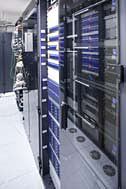Transitioning To Tapeless
Manfred Jung is the Project Manager and one of the responsible persons for HDTV studio renewal projects at SWR.

Südwestrundfunk (SWR), or Southwestern Broadcasting, is the joint regional public broadcasting corporation of the German federal states of Baden-Württemberg and Rheinland-Pfalz. Within Germany’s association of public broadcasters (ARD), SWR is the second-largest member. We also operate the Saarländischer Rundfunk (SR) channel and provide 18% of the programming for the nationwide public HD channel, Das Erste. In all, our broadcast area includes approximately 15 million people.
Our three regional facilities are located in Baden-Baden, Stuttgart, and Mainz. In Baden-Baden, where we have relied on Omneon Spectrum systems for transmission since 2004, we have extended our Omneon infrastructure to support the upgrade of our studio production from a tape-based workflow to file-based operations. Given our experience using the Spectrum server for playout, we knew that the Omneon HD Spectrum server system would provide the flexible architecture and bandwidth that we required for HD studio production.
The Omneon server’s support for XDCAM HD 4:2:2 media and its easy integration with our chosen control solution were key to our ability to automate and further simplify our operations. Our familiarity with the Omneon systems also was a benefit, as our staff already had experience working with and maintaining the Spectrum server system. Systems integrator BFE Studio und Medien Systeme – Mainz supplied the new Omneon HD Spectrum system for our production studio upgrade, which is one in a series of steps we’re taking towards completely tapeless operations. We use the HD Spectrum system to support recording and playback in two studios.
Server operations are managed and controlled by the Solutions for Media (S4M) ClipJOCKEY system during production. The ClipJOCKEY system provides user-defined presets that enable dynamic allocation of centralized media server I/O, storage, and NLEs to different productions or different studios according to their specific requirements.
One advantage of pairing ClipJOCKEY with the Spectrum system in the production environment is that takes can be sent to a Final Cut Pro edit system for craft editing. We’ve employed MXF4mac software to enable native support for MXF files in QuickTime applications, and this capability facilitates high interoperability and efficiency throughout our workflow – from on-set recording with the Spectrum server, through edit-in-place with Final Cut Pro, to playout via the Spectrum system.
By eliminating studio tapes from the production process and using a common format from acquisition to playout, we’ve been able to increase our flexibility in preparing programming for air, improve overall reliability, and lower our capital and operational costs.
The faster-than-real-time edit fusing and play-to-air functionality help our production staff to maximize workflow efficiency and meet short deadlines.
Get the TV Tech Newsletter
The professional video industry's #1 source for news, trends and product and tech information. Sign up below.
